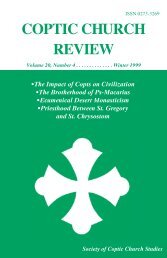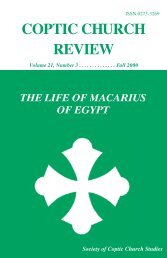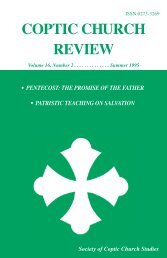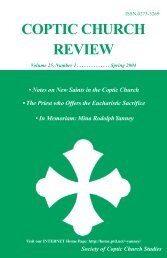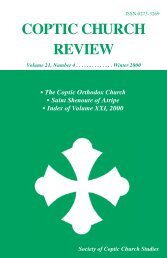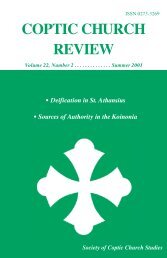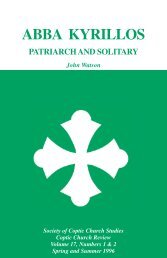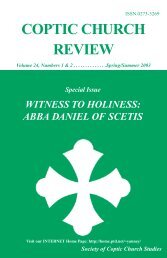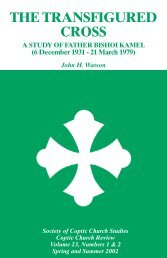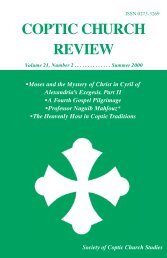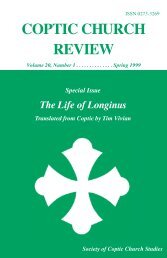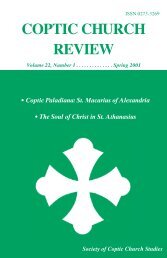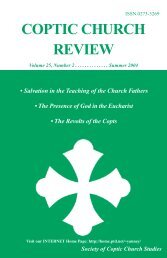2004 Fall.Vol25.#3.pdf - Coptic Church Review
2004 Fall.Vol25.#3.pdf - Coptic Church Review
2004 Fall.Vol25.#3.pdf - Coptic Church Review
Create successful ePaper yourself
Turn your PDF publications into a flip-book with our unique Google optimized e-Paper software.
86 <strong>Fall</strong> <strong>2004</strong> • <strong>Coptic</strong> <strong>Church</strong> <strong>Review</strong> - Volume 25, Number 3<br />
The Orthodox <strong>Church</strong> believes that after consecration the bread<br />
and wine become in very truth the Body and Blood of Christ:<br />
they are not mere symbols, but the reality. But while Orthodoxy<br />
has always insisted on the reality of the change, it has never<br />
attempted to explain the manner of the change: the Eucharistic<br />
Prayer in the Liturgy simply uses the neutral term metabolo, to<br />
“turn about,” “change,” or “alter.” 23<br />
Catholic Scholasticism and the Eucharist<br />
On the other hand, Western churches tried to explain what happens to the<br />
bread and wine by the use of current scientific and philosophical theories. Probably<br />
they were forced to do that by the many heresies which appeared in the Middle<br />
Ages that taught that the Eucharist is merely a symbol for the Lord’s Body and<br />
Blood. These heresies, however, have left no permanent impact upon ancient belief<br />
till the Protestant Reformation in the 16th century. From the 12th and up to the<br />
middle of the 20th century, the Roman Catholic <strong>Church</strong> and the West in general<br />
explained Christian dogmas by the use of Scholastic Theology. This was the only<br />
system of theology known through all these centuries. Scholastic theology was<br />
based upon the philosophy of Aristotle as translated from the Arabic version of his<br />
works. These were mixed with the teaching of Moslem scholars; works of Ibn-<br />
Rushd and Ibn-Sina became very popular in the West. The scholastics explained<br />
the change in the Eucharist as a change in the essence (i.e. the whole substance of<br />
the bread and wine are converted to the whole substance of Christ’s Body and<br />
Blood), while the accidents (i.e. the appearances of the bread and wine) remain the<br />
same. Catholic theologians started these Latin terms in the thirteenth century. They<br />
were officially used in the Council of Trent (1545-1563), which the Roman<br />
Catholic <strong>Church</strong> held in order to respond to Protestant questions.<br />
Using the scholastic system, both Catholic and Protestant missionaries spread<br />
their respective beliefs to all Orthodox churches. At a time when patristic writings<br />
were only in the original languages, the Orthodox had no way of defending their<br />
faith against the Protestant missionaries except by using Roman Catholic material.<br />
This is how the whole system of Scholasticism entered into Orthodox manuals of<br />
theology. Since the 15th century the Eastern Orthodox <strong>Church</strong> has used the Greek<br />
word metabole to translate the Latin term transubstantiation. The doctrine was<br />
given formal approval in 1672 by the Synod of Jerusalem. 24 Transubstantiation and<br />
the terms used by Aristotle, like “essence” and “accident,” became familiar terms<br />
in Orthodox books! 25<br />
23 Bishop Kallistos (Timothy) Ware: The Orthodox <strong>Church</strong>. Middlesex, England: Penguin Books,<br />
1963: 290.<br />
24 F.L. Cross & E.A. Livingstone, The Oxford dictionary of the Christian <strong>Church</strong>, 3rd edition, 1997:<br />
1637<br />
25 The Orthodox <strong>Church</strong>, ibid. 223; Habib Guirgis: The Seven Sacraments; Samuel Azer Guirgis:<br />
The Eucharist, 2nd edition, n p. 223.




